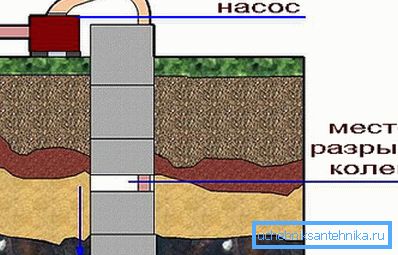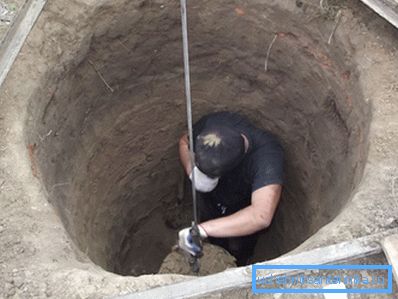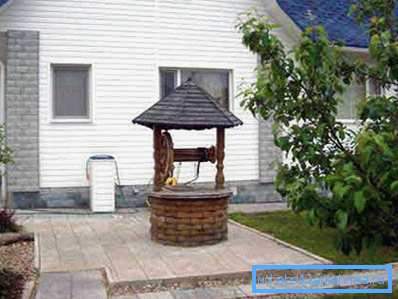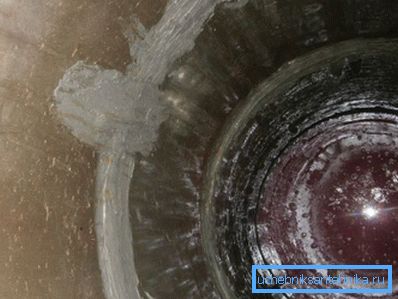Dirty water in the well: sources of pollution and cleaning
During the operation of the source, its owner may have a variety of questions - for example, why the water from the well turns green or what causes metallic taste. And since problems from this series arise in almost any area, it is worth examining them in advance.

Reasons for declining water quality
Even with the ideal operation of the well, sooner or later it is possible to note a decrease in water quality. Moreover, it can manifest itself in different ways, depending on the reasons for it.
Below we will try to consider the most common options:
- Mechanical contamination occurs most frequently.. It is a consequence of the silting process - the accumulation in the bottom layer of a large amount of fine sand, silt and clay particles. With heavy silting, small granules fall into a bucket or pump, and the water becomes rather turbid.

- White water in the well is another sign of the soil minerals getting into the source.. Such a color change can be caused either by the fact that the well has not been reached to the required depth, or by the infiltration of the soil solution through carbonate rocks and its entry into the water through the joints of the concrete rings of the well.
- The effects of bacterial contamination look different. As a rule, it is observed with rare use of the source and the stagnation of water. In this case, the water turns green and gets an unpleasant smell. The main reason is the accumulation of waste products of bacteria and microscopic algae.

- The result of the work of other microbes - iron and sulfur bacteria - can be the smell of hydrogen sulfide and film on the water in the well. These microorganisms exist due to the energy of chemical reactions, and at the same time they convert insoluble forms of iron and sulfur into soluble ones. As a result - active gas emission and color change.
Note! Slightly yellowish, so-called peat water in the well has no relation to iron bacteria. The presence of a light yellow tint is a consequence of the close occurrence of the peat horizon. Humic acid, dissolving, penetrate into the water and paint it.
- Salt water in the well may also appear for several reasons.. This is either the passage of the salt-bearing horizon (then the taste will be noted constantly), or the ingress of potash fertilizers into the water from the nearby fields. In the second case, you need to seriously think about waterproofing the entire casing.
As you can see, there can be many reasons. That is why experts advise against any problems (bitter water in the well, an unpleasant smell, etc.) to perform sampling and transfer them for analysis in the SES laboratory. Of course, the price of such a study will be rather big (from 2.5 to 10 thousand rubles), but then we can determine the cause of the problems as accurately as possible.
Pollution control
Preventive measures

As a rule, they begin to fight with contamination of well water only when its consequences have become apparent. In fact, the proper arrangement of the source is a reliable insurance against the overwhelming majority of problems.
The instruction must be executed clearly - then everything will be fine:
- Before starting work, it is necessary to conduct exploration of the aquifer, or at least inspect the wells that already exist in the adjacent areas. This will help you plan your work and avoid unpleasant surprises such as quicksand, peatlands, etc.
Note! Sometimes you have to completely abandon the idea of digging a well and bore a more expensive well.
- It is necessary to dig a well in such a way that the aquifer is completely covered. Otherwise, if we do not reach the waterproof layer, the silting will continue almost constantly.
- Equipping the casing, you must carefully seal the joints of concrete rings. Also it is necessary to process the outer side of the concrete, otherwise brown water in the well will appear very soon.
- Along the perimeter of the well should make a concrete pavement. It will prevent the penetration of rain and melt water, which means that minerals from the surface will not fall inside.

Cleaning and fighting silting
Fighting the pollution of well water with your own hands is quite possible.
In this case, it is necessary to begin with a simple mechanical cleaning followed by disinfection:
- At the first stage we pump out water to the minimum level. Ideally, the bottom should appear with a layer of silt and clay.
- After pumping, we perform preliminary disinfection, pouring bleach into the well and closing it for a day.
- After 24 hours, we ventilate the mine and proceed to the treatment of the walls. Going down the stairs or in the hanging cradle, we remove the algae deposits, mineral deposits, etc. from the walls with a scraper and brush.
- We rub the cracks, cracks and gaps between the concrete rings dry and seal them with a quick-drying sealant containing “liquid glass” or similar compounds.
- From the bottom we collect all the silt and everything that got there during the cleaning of the walls. All that is collected - put in a bucket and lift to the surface on a rope.

Tip! When working at depth, it is imperative that you follow the safety instructions. It is necessary to use overalls, durable shoes, personal protective equipment, etc. You should also take care of the presence of a partner who will insure us.
Further we carry out repeated disinfection:
- With a solution of bleach or potassium permanganate, we coat all walls.
- The rest of the solution is poured to the bottom.
- Close the lid of the well for a day or two.
- After the completion of this period, open the lid of the shaft and perform ventilation.

Then we need to perform a rollout.
The instruction in this case is simple:
- Drainage pump set as low as possible.
- We start pumping out, making sure that clay and sand rise together with water.
- We stop the work of the pump only after clear water comes out of the hose.
At the final stage we fall asleep on the bottom of a gravel filter for a well, which will perform the task of mechanical cleaning. Of course, gravel cannot cope with complex contaminants, but rusty water in the well containing insoluble iron will be cleaned to an acceptable level of quality.
Tip! The filter gravel must be rinsed, and not once. Also, do not use a filling of limestone rocks, otherwise you will not be able to avoid the appearance of an oily film on the surface of water.
Finishing water treatment
If all these activities have not brought the desired effect, then the problem is in the water itself.
The high content of solutes can be very unpleasant, and should be fought with complex methods:

- The easiest way to perform the settling of the liquid. To do this, water from the well is served in a large container, the fence from which is made only after some time. Part of the suspended pollutants will sink to the bottom, from where it can be easily removed with regular cleaning.
- It is much harder to deal with high content of iron and sulfur in a dissolved state. As a rule, for this purpose, filters with fillers based on activated carbon are used.
- However, additional oxidation is necessary to remove the bulk of iron, hydrogen sulfide and other gases. That is why, before the iron is removed from the well, it is placed in a hermetically sealed container, into which air from the pump enters. Saturation of water with oxygen contributes to the final oxidation of substances and their precipitation.

- Instead of oxygen oxidation, you can use chemical reagents. For this purpose, sodium hypochlorate, hydrogen peroxide, potassium permanganate, etc. are most in demand.
- Ozone units are even more effective, however they are very expensive. For this reason, ozone cleaning is used only in large enterprises.
If none of these methods helps, then it remains only to boil water. However, it is worthwhile to turn to this method only when no other technology helps.
Conclusion
Red water in the well, the appearance of an unpleasant odor, film on the surface - all these are signs of significant pollution. In most cases, you can fight him, but you have to carefully analyze the situation and make an effort. The video in this article contains additional information on this topic, which will be useful to anyone interested in well water treatment technologies.